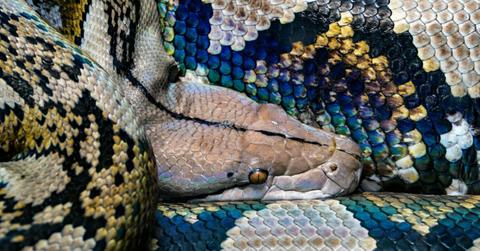Could Global Warming Bring Back Colossal Snake That Weighed Over One Ton and Longer Than School Bus?

Giant snake in India could have been the length of a bus and weighed a ton, researchers say.
Researchers recently announced that an ancient colossal snake found in India might have exceeded the length of a school bus and weighed as much as a ton.
Fossils discovered near a coal mine unveiled a snake estimated to have stretched between 36 feet and 50 feet, comparable in size to the largest known snake, which once inhabited what is now Colombia, measuring approximately 42 feet.
The largest living snake today, Asia’s reticulated python, reaches a length of 33 feet. The newly discovered giant, named Vasuki indicus after the mythical snake king Vasuki, who coils around the neck of the Hindu deity Shiva, lived some 47 million years ago in the swampy evergreen forests of western India.
Researchers estimate that it could have weighed up to 2,200 pounds, according to a report published in the journal Scientific Reports.
Debajit Datta, a co-author of the study from the Indian Institute of Technology Roorkee, stated, “Considering its large size, Vasuki was a slow-moving ambush predator that would subdue its prey through constriction.”
Fragments of the snake’s backbone were discovered in 2005 near Kutch, Gujarat, in western India, by co-author Sunil Bajpai, who is also from the same institute. The researchers compared more than 20 fossil vertebrae to skeletons of living snakes to estimate the size.
- What Lies Beneath: NASA Scientist Believes Aliens May Have Found 'Perfect' Hiding Spot in Earth's Oceans
- Global Threat: Russia Insider Warns West of 'World War Using Nuclear Weapons' Amid Escalating Support for Ukraine
- Countdown to Disaster? Ex-NATO Official Warns Russia, Iran and China Could Wage WWIII in Just Years
Though it’s unclear exactly what Vasuki ate, other fossils found nearby indicate that the snake lived in swampy areas alongside catfish, turtles, crocodiles and primitive whales, which may have been its prey, Datta explained.
The other extinct giant snake, Titanoboa, was discovered in Colombia and is estimated to have lived around 60 million years ago.
Never miss a story — sign up for the Front Page Detectives newsletter. Be on the scene the moment news breaks.
Both of these colossal snakes have one thing in common: they lived during periods of exceptionally warm global climates, said Jason Head, a paleontologist at Cambridge University who was not involved in the study.
“These snakes are giant cold-blooded animals,” he said. “A snake requires higher temperatures” to grow into large sizes.
In theory, global warming could bring back monster-sized snakes, but the climate is now warming too quickly for the animals to evolve again into giants, he said.
Become a Front Page Detective
Sign up to receive breaking
Front Page Detectives
news and exclusive investigations.
